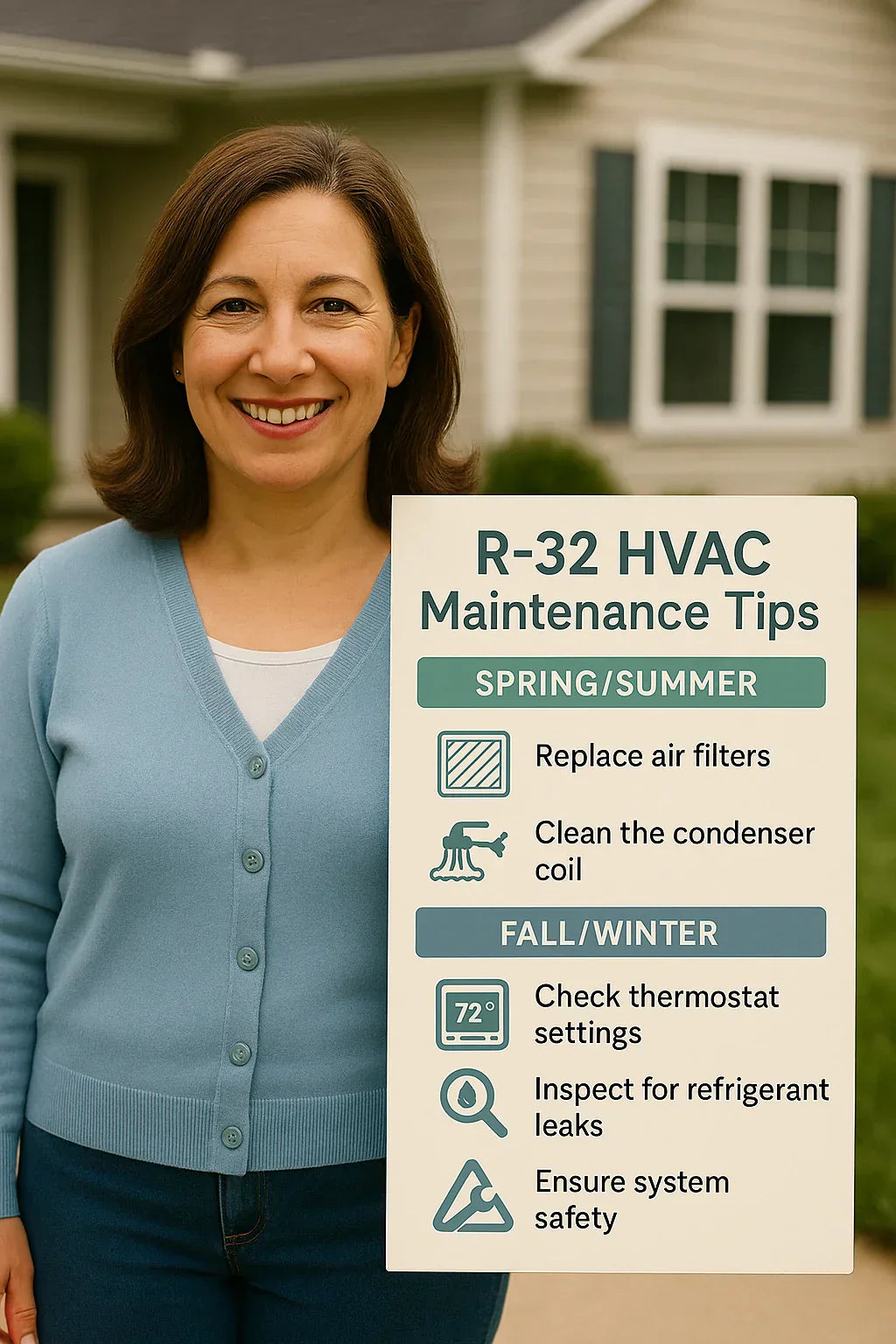Switching to an R-32 HVAC system can improve your home’s energy efficiency and environmental impact—but like any high-performance system, it requires proper care to keep running smoothly. While maintenance for R-32 systems is similar to traditional R-410A systems, there are a few important differences you need to know.
In this guide, we’ll break down routine maintenance steps, safety tips specific to R-32 (a mildly flammable refrigerant), and how to keep your system efficient, compliant, and long-lasting.
🔍 Why Proper Maintenance Matters
All HVAC systems need periodic maintenance to:
-
Maintain peak efficiency
-
Extend the system’s lifespan
-
Prevent costly repairs
-
Keep warranties valid
-
Ensure safe refrigerant handling
R-32 systems have an edge in efficiency and sustainability—but only if properly serviced and cleaned.
👉 Read: Why Routine HVAC Maintenance Saves You Money
🛑 Important Note About R-32
R-32 is classified as A2L, which means:
-
Low toxicity ✅
-
Mildly flammable ⚠️
This means homeowners should never attempt refrigerant handling themselves. Always use an EPA-certified technician with experience in A2L refrigerants.
👉 ASHRAE Guide to A2L Refrigerants
🗓️ Seasonal Maintenance Checklist
✅ Spring/Summer (Cooling Season)
-
Clean or replace air filters monthly
-
Clear debris from around the outdoor condenser
-
Rinse condenser coils with gentle water pressure
-
Inspect refrigerant lines and insulation
-
Check thermostat settings and calibrate
✅ Fall/Winter (Heating Season for Dual Fuel or Heat Pump)
-
Clean filters monthly
-
Inspect outdoor unit for snow, ice, and leaf buildup
-
Verify proper switching from heat pump to furnace (dual fuel)
-
Listen for unusual noises during startup
-
Schedule a professional inspection before the first freeze
👉 Filter Maintenance Guide – Department of Energy
🧪 R-32 System-Specific Maintenance Needs
-
Leak Detection:
-
Technicians should use A2L-compatible leak detectors
-
Always inspect for leaks at joints and fittings
-
-
Refrigerant Pressure Checks:
-
R-32 operates at a slightly higher pressure than R-410A
-
Incorrect pressure can reduce efficiency or trigger safety cutoffs
-
-
Drain Line Cleaning:
-
Prevent algae and clogs that reduce system performance
-
-
Electrical Components:
-
Inspect wiring and capacitors, especially after storms
-
-
Flame Sensors (if dual fuel):
-
Clean and test sensors to ensure safe furnace ignition
-
👉 HVAC School: Handling A2L Refrigerants
🧯 Is It Safe to DIY Anything with R-32?
Yes, but only non-refrigerant tasks. Homeowners can safely:
-
Change air filters
-
Rinse off the exterior of the condenser coil
-
Replace thermostat batteries
-
Trim vegetation away from the unit
Don’t:
-
Open refrigerant lines
-
Add or remove refrigerant
-
Attempt to repair leaks
-
Use flammable cleaners near the system
👉 EPA Section 608 Certification Requirements
🔄 How Often Should I Get a Professional Inspection?
At minimum, once per year—ideally in the spring before peak cooling season. For systems in cold or humid climates, schedule a second visit before winter to prep for heating use.
If your system is still under warranty, annual service may be required to maintain coverage.
🧾 How Much Does R-32 Maintenance Cost?
Costs are generally in line with standard HVAC service, with minor increases for A2L-certified techs.
| Service | Typical Cost |
|---|---|
| Annual inspection | $120–$200 |
| Coil cleaning | $75–$150 |
| Leak detection | $100–$250 |
| Filter replacement (DIY) | $15–$40 each |
Ask your provider if they’re R-32 certified and include it in a maintenance plan.
👉 Find Licensed Contractors – ACCA
🔧 Tips to Extend the Life of Your R-32 System
-
Install a smart thermostat for better run-time control
-
Keep at least 2 feet of clearance around the outdoor unit
-
Upgrade to MERV 11–13 filters for better airflow and indoor air quality
-
Avoid oversizing: short-cycling reduces compressor lifespan
-
Track energy use with a home energy monitor
✅ Final Thoughts: Treat It Like a High-Performance Machine
R-32 HVAC systems offer next-level energy efficiency, but they require routine, knowledgeable care to stay safe and effective. Homeowners can handle the basics — like filter changes and airflow checks — but leave the refrigerant-side tasks to the pros.
With regular maintenance and a certified technician, your R-32 system can deliver decades of comfort, lower bills, and eco-friendly operation.
👉 Browse certified R-32-ready systems at The Furnace Outlet
In the next topic we will kow more about: Can I Replace R-410A Equipment with R-32? What to Ask Your Installer







